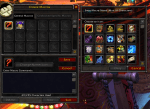In an in-world presentation, Lesley Scopes aka Light Sequent presented ‘Learning Archetypes as tools of Cybergogy: A structure for eTeaching in Second Life‘ to VWBPE 2010. The presentation was worth watching for the information that was presented, but of particular interest was the presentation method. Lesley used 3D world tools to present rather than bringing the more frequently used 2D tool (PowerPoint) into the 3D world. This made the presentation more engaging than presentations I typically attend. The 3D models brought a unique physicality to the presentation that served to interest the audience.

A 3D representation is used to make a point
The presentation took advantage of tools not available in a 2D platform and perhaps demonstrates the evolution of 2D to 3D much like the evolution of overheads to PowerPoint was a few years ago. Using the tools available in virtual worlds requires that the presenter have some skills in the area of building. Light Sequent explained that the 3D items could contain scripts for additional interaction between audience and information 3D graphic. At the very least the presenter should be able to place the correct 3D object in front of the audience at the appropriate time but the actual building of the objects could be built by someone adept at building.
I look forward to using this method of presentation in the future, though I’ll need to label objects carefully so I don’t accidentally place a shoe or a silly gadget in front of my audience.







